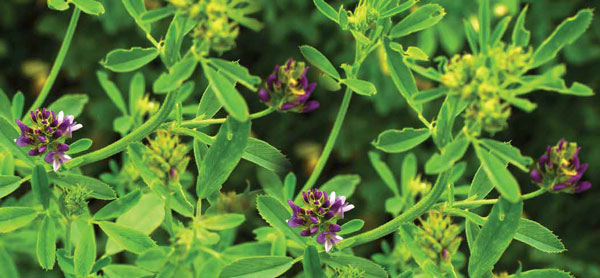Alfalfa : EkoNiva and partners share experience
11 January 2019 News from the Company
Russia’s agri-food policy and efficient state support promote intensive development of cattle farming. The increase in cattle population requires an expansion of the area under forages and the use of varieties with a high yield potential and a high feed value. An absolute champion among farm crops in regards to protein content in feed unit per hectare equivalent is unquestionably alfalfa.

No wonder alfalfa is called the queen of fields: this crop enriches the soil with organic matter, increases its fertility, acts as biological drainage during irrigation, preventing soil salinisation and nutrient leaching beyond the root zone. The main advantage of alfalfa is that it constitutes a weighty share of a nutritious and high-quality cattle feed. Leading specialists of EkoNiva-APK Holding, the largest raw milk producer in Russia and Europe, confirm this fact.
‘Along with maize, alfalfa is widely used in animal feeding rations’, says Mikhail Gurnov, Livestock Farming Director of EkoNiva-APK Holding. ‘Such popularity of alfalfa is explained by its high nutritive value and crude protein content in the green mass.’
Highly-adaptive alfalfa varieties of foreign plant breeding are beyond competition due to their improved hardiness, survivability in both severe wintering conditions and unfavourable growing conditions during the vegetation season not only in central Russia, but also in Siberia. For example, variety Dakota® (Medicago sativa L.) it has taken its rightful place in the commercial forage seed production of EkoNiva-Semena and is successfully produced at the livestock enterprises of the holding.
‘The key advantages of the alfalfa we grow to feed our cattle include stable yields, a good plant density, a high ripening rate in harsh weather conditions and lodging resistance in windy weather’, says Vyacheslav Ionov, Deputy Executive Director of EkoNivaAgro-East. ‘Availability of high-yielding alfalfa varieties enables us to balance the ration properly by using more forages.’
Substantial saving on the purchase of expensive protein additives is the main driver behind growing alfalfa varieties of western genetics in EkoNiva’s fields.
‘High nutritive quality gives these varieties an edge over their counterparts, including those of domestic plant breeding’, continues Mikhail Gurnov. ‘It enables us to put up haylage with crude protein content up to 24 percent, which eliminates the need for additives, and that is our priority.’
No less important is that the variety Dakota® of American genetics has a high disease resistance, particularly anthracnose, and has a good regrowth habit even in severe climatic conditions.
Yudanovskiye Prostory enterprise (Bobrov district, Voronezh oblast) with a dairy herd of 1,000 head routinely makes three cuts, sometimes even four.
‘We are happy with the alfalfa seeds which we have been buying from EkoNiva for over 5 years’, says Aleksandr Bezotosny, Chief Agronomist of Yudanovskiye Prostory. ‘Now we reap 11-12 tonnes per hectare. We used to grow alfalfa of Russian origin, its yield hardly ever exceeding 7-8 tonnes per hectare. With the new variety, the yield is high, forage quality has improved, and the milk production has increased. What’s not to like?’
The testimonial once again proves that alfalfa varieties of western plant breeding guarantee top quality and high yields, a perfect choice for forward-thinking farmers.
By Tatyana IGNATENKO
